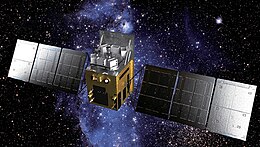Hard X-ray Modulation Telescope
 Rendering of HXMT | |
| Mission type | Astronomy |
|---|---|
| Operator | CAS / IHEP |
| COSPAR ID | 2017-034A |
| SATCAT no. | 42758[1] |
| Website | http://www.hxmt.org/ |
| Mission duration | Elapsed: 7 years, 7 months, 9 days[2] |
| Spacecraft properties | |
| Launch mass | 2,800 kg (6,200 lb)[2] |
| Dimensions | 2.0 × 2.0 × 2.8 m (6.6 × 6.6 × 9.2 ft)[2] |
| Start of mission | |
| Launch date | June 14, 2017, 03:00:00 UTC [2] |
| Rocket | Long March 4B[2] |
| Launch site | 603 Launch Pad of the LC43 Launch Complex, Jiuquan Satellite Launch Center[2] |
| Orbital parameters | |
| Reference system | Geocentric[1] |
| Regime | Low Earth[1] |
| Semi-major axis | 6,920 km (4,300 mi)[1] |
| Eccentricity | 0.0006597[1] |
| Perigee altitude | 545 km (339 mi)[1] |
| Apogee altitude | 554.1 km (344.3 mi)[1] |
| Inclination | 43.0°[1] |
| Period | 95.5 minutes[1] |
| Mean motion | 15.079 rev/day[1] |
| Epoch | 2017-06-22 11:32:39 UTC[1] |

Hard X-ray Modulation Telescope (HXMT) also known as Insight (Chinese: 慧眼)[3] is a Chinese X-ray space observatory, launched on June 15, 2017[2] to observe black holes, neutron stars, active galactic nuclei and other phenomena based on their X-ray and gamma-ray emissions.[4] It is based on the JianBing 3 imagery reconnaissance satellite series platform.
The project, a joint collaboration of the Ministry of Science and Technology of China, the Chinese Academy of Sciences, and Tsinghua University, has been under development since 2000.
Payload
[edit]The main scientific instrument is an array of 18 NaI(Tl)/CsI(na) slat-collimated "phoswich" scintillation detectors, collimated to 5.7°×1° overlapping fields of view.[5] The main NaI detectors have an area of 286 cm2 each, and cover the 20–200 keV energy range. Data analysis is planned to be by a direct algebraic method, "direct demodulation",[6] which has shown promise in de-convolving the raw data into images while preserving excellent angular and energy resolution.
The satellite has three payloads, the high energy X-ray Telescope (20–250 keV), the medium energy X-ray telescope (5–30 keV), and the low energy X-ray telescope (1–15 keV)[2]
See also
[edit]References
[edit]- ^ a b c d e f g h i j k HXMT (HUIYAN)
- ^ a b c d e f g h Rui C. Barbosa (14 June 2017). "China launches X-ray telescope via Long March 4B". NASASpaceFlight.com. Retrieved 15 June 2017.
- ^ "China launches space telescope to search for black holes, pulsars - Xinhua | English.news.cn". news.xinhuanet.com. Archived from the original on June 15, 2017.
- ^ Andrew Jones. "Tiangong-2 to launch next week in step towards Chinese space station". gbtimes.com. Sep 8, 2016. Archived from the original on 2018-03-19.
- ^ HXMT.cn, Configuration Archived July 7, 2011, at the Wayback Machine (Hard X-ray telescope design) c.2004
- ^ HXMT.cn, The direct demodulation method Archived July 7, 2011, at the Wayback Machine (Imaging by direct deconvolution) c.2004
